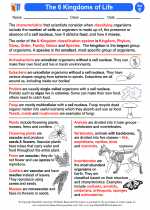The 6-Kingdoms of life -> steel
Steel: An Overview
Steel is a versatile and widely used material that is made from iron and carbon. It is a critical component in many industries, including construction, automotive, and manufacturing. Steel is valued for its strength, durability, and ability to be easily shaped into various forms.
Composition of Steel
Steel is primarily composed of iron and carbon, with the carbon content typically ranging from 0.2% to 2.1%. In addition to iron and carbon, steel may also contain small amounts of other elements such as manganese, chromium, nickel, and molybdenum, which help to enhance its properties.
Types of Steel
There are several different types of steel, each with its own unique properties and applications. Some common types of steel include:
- Carbon Steel: Contains primarily iron and carbon, and is known for its strength and hardness.
- Alloy Steel: Contains additional alloying elements such as manganese, nickel, or chromium, which enhance specific properties such as corrosion resistance or toughness.
- Stainless Steel: Contains chromium, which provides excellent resistance to corrosion and rust.
- Tool Steel: Designed for use in making tools, this type of steel is known for its hardness and resistance to abrasion.
Production of Steel
Steel is produced through a process called smelting, which involves the extraction of iron from iron ore and the addition of carbon and other elements to create the desired steel composition. The most common method of steel production is through the use of a blast furnace, where iron ore, coke, and limestone are heated to produce molten iron, which is then converted into steel.
Properties of Steel
Steel possesses a number of desirable properties, including:
- Strength: Steel is known for its high strength and ability to withstand heavy loads.
- Durability: Steel is highly durable and resistant to wear and tear.
- Malleability: Steel can be easily shaped and formed into various structures and objects.
- Corrosion Resistance: Some types of steel, such as stainless steel, exhibit excellent resistance to corrosion.
Applications of Steel
Steel is used in a wide range of applications, including:
- Construction: Steel is commonly used in the construction of buildings, bridges, and infrastructure due to its strength and durability.
- Automotive: Steel is a key material in the automotive industry, used in the production of vehicle bodies, chassis, and engine components.
- Manufacturing: Steel is used to create a variety of tools, machinery, and equipment for manufacturing processes.
- Household Goods: Steel is used in the production of household items such as appliances, cutlery, and cookware.
Study Guide
To study and understand the topic of steel, consider the following key points:
- Understand the composition of steel, including the role of iron, carbon, and other alloying elements.
- Learn about the different types of steel and their unique properties and applications.
- Explore the production process of steel, including the methods used to extract iron and create steel alloys.
- Examine the properties of steel, such as strength, durability, malleability, and corrosion resistance.
- Investigate the various applications of steel in industries such as construction, automotive, manufacturing, and consumer goods.
By grasping these fundamental aspects of steel, you will gain a comprehensive understanding of this essential material and its significance in various fields.
.◂Science Worksheets and Study Guides Fifth Grade. The 6-Kingdoms of life

 Activity Lesson
Activity Lesson
 Worksheet/Answer key
Worksheet/Answer key
 Worksheet/Answer key
Worksheet/Answer key
 Worksheet/Answer key
Worksheet/Answer key
 Worksheet/Answer key
Worksheet/Answer key
 Vocabulary/Answer key
Vocabulary/Answer key
 Vocabulary/Answer key
Vocabulary/Answer key
 Vocabulary/Answer key
Vocabulary/Answer key
 Vocabulary/Answer key
Vocabulary/Answer key
